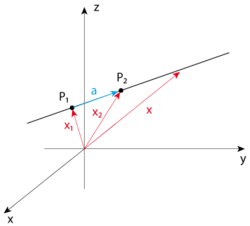Calculus/Lines and Planes in Space
< CalculusIntroduction
For many practical applications, for example for describing forces in physics and mechanics, you have to work with the mathematical descriptions of lines and planes in 3-dimensional space.
Parametric Equations
Line in Space
A line in space is defined by two points in space, which I will call and . Let be the vector from the origin to , and the vector from the origin to . Given these two points, every other point on the line can be reached by
where is the vector from and :

Plane in Space
The same idea can be used to describe a plane in 3-dimensional space, which is uniquely defined by three points (which do not lie on a line) in space (). Let be the vectors from the origin to . Then
with:
Note that the starting point does not have to be , but can be any point in the plane. Similarly, the only requirement on the vectors and is that they have to be two non-collinear vectors in our plane.
Vector Equation (of a Plane in Space, or of a Line in a Plane)
An alternative representation of a Plane in Space is obtained by observing that a plane is defined by a point in that plane and a direction perpendicular to the plane, which we denote with the vector . As above, let describe the vector from the origin to , and the vector from the origin to another point in the plane. Since any vector that lies in the plane is perpendicular to , the vector equation of the plane is given by
In 2 dimensions, the same equation uniquely describes a Line.
Scalar Equation (of a Plane in Space, or of a Line in a Plane)
If we express and through their components
writing out the scalar product for provides us with the scalar equation for a plane in space:
where .
In 2d space, the equivalent steps lead to the scalar equation for a line in a plane: